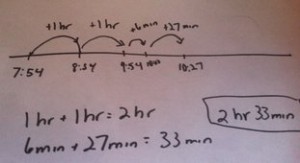 I started the race at 7:54 am and crossed the finish line at 10:27 am. How long did it take me to run the race?
I started the race at 7:54 am and crossed the finish line at 10:27 am. How long did it take me to run the race?
This problems, often labeled as elapsed time problems, are difficult for students to solve. One reason is that students often have trouble coordinating between the two different units–hours and minutes. In fact, in one study, only 58% of eighth-grade knew that 150 minutes is equal to 2 1/2 hours (Jones and Arbaugh 2004).
I recently witnessed this first hand in a third grade class. The students really struggled with these types of problems. Many students wanted to subtract 754 from 1027. I didn’t know what to do. So I went to the research and found some work by Juli Dixon that used open number lines to help students reason about these types of problems.
Open number lines can be used by students to count up, count down and find distances between numbers.
Here’s one way to use the open number line to solve the problem above.
Now, that’s not the first problem I had students begin with, but I wanted you to get a sense of how the open number line works.
Dixon also notes that you should allow students to use the number line in ways that make sense to them. You should not prescribe one way of using it to solve a problem, as there are multiple ways that work. Students can share the different strategies with the class.
As I’ve mentioned before, I’m all for diagrams that allow students to reason about problems. In this case, I love that the diagrams allow for students to record what is happening as it is very hard to keep track of all the steps. I’ll talk more about how I built up to this another time, but I’m curious to hear what you have done with your students.
Want to know more? Check out the articles below:
Dixon, Juli K. “Tracking Time.” Teaching Children Mathematics, 19 (August 2008): 18-24
Jones, Dustin L., and Fran Arbaugh. “What Do Students Know about Time?” Mathematics Teaching in the Middle School 10 (September 2004): 82–84.
Monroe, Eula Ewing, Michelle P. Orme, and Lynnette B. Erickson. “Working Cotton: Toward an Understanding of Time.” Teaching Children Mathematics 8 (April 2002): 475–79.
